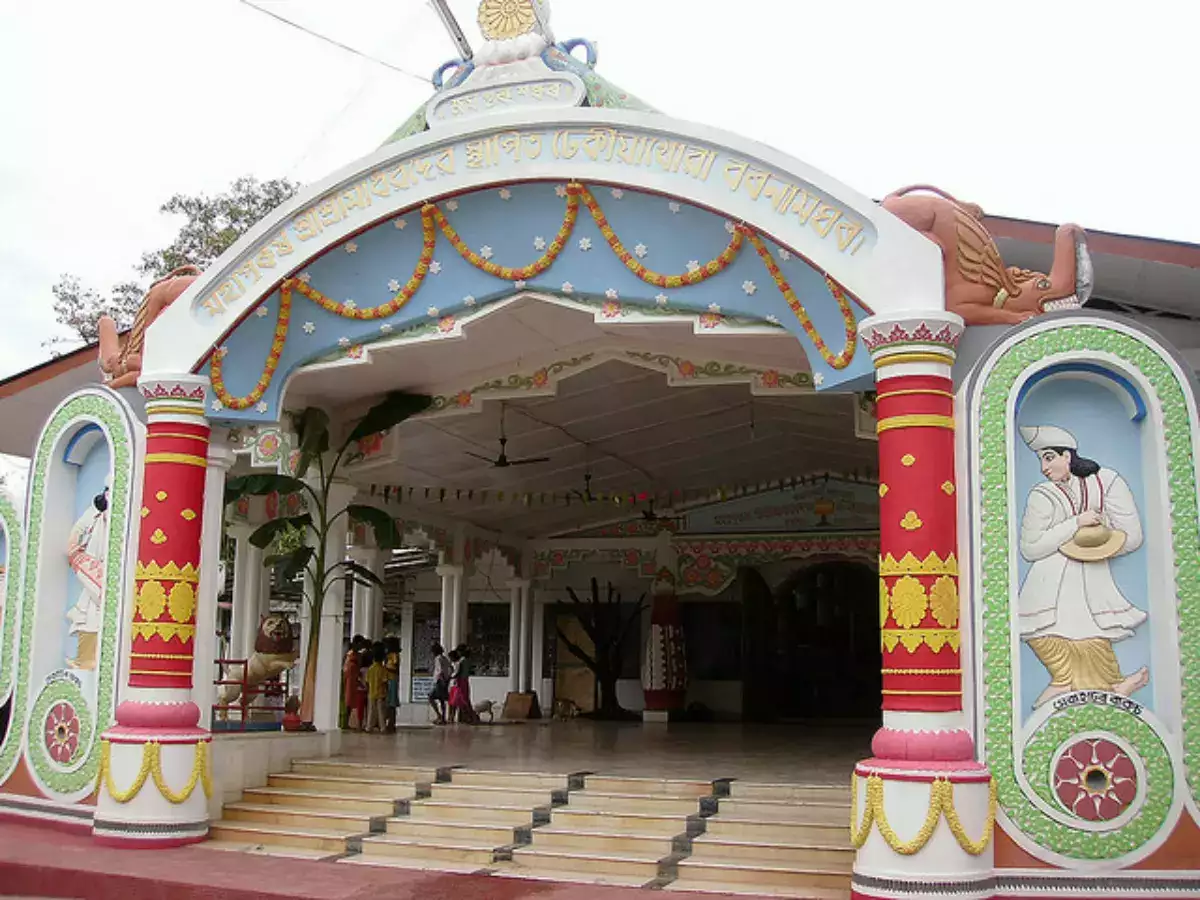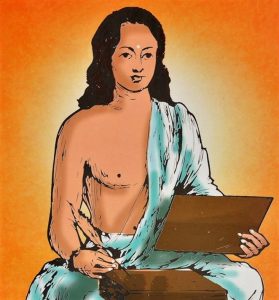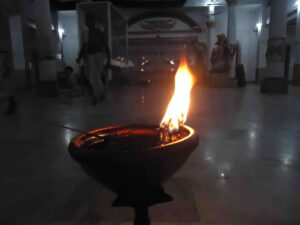A Journey into Dhekiakhowa Bornaamghar
Dhekiakhowa Bornaamghar, located in Jorhat district, Assam, India, holds a significant place in the hearts of devotees. Established by the saint-reformer Madhavdeva in 1528 (1450 Saka), this naamghar (prayer hall) has a rich history and continues to be a spiritual hub for thousands of people. Here’s a detailed exploration of its origins, legends, and cultural significance.
Origins and Establishment
Madhav Deva
Madhavdeva, a devoted disciple of the revered saint-reformer Srimanta Sankardeva, founded Dhekiakhowa Bornaamghar in 1528 (1450 Saka).
The naamghar (prayer hall) is located in Dhekiakhowa village, approximately 15 km east of Jorhat city in Assam, India.
Significance: The naamghar holds immense historical and spiritual importance for the local community and beyond.
Key Points:
Madhavdeva’s Vision: Madhavdeva established the naamghar after a divine vision. Legend has it that during his stay in Dhekiakhowa village, an old woman served him simple rice with Dhekia Saak (Fiddlehead Fern). Her humble offering deeply moved Madhavdeva, who decided to create a sacred space there.
Continuous Lamp
Continuous Lamp: In 1528, Madhavdeva lit an earthen lamp within the premises. Remarkably, this lamp has been burning uninterrupted ever since. Priests diligently replenish it with mustard oil.
Architectural Features: The main pillar of the naamghar is crafted from a Sal tree, guided by a divine vision experienced by one of the bhakats (monks).
Spiritual Gathering: Devotees and pilgrims visit Dhekiakhowa Bornaamghar throughout the year. The sacred month of Bhado (August–September) witnesses a surge in visitors, as it marks the death anniversaries of both Srimanta Sankardeva and Madhavdeva.
In summary, Dhekiakhowa Bornaamghar stands as a testament to Assam’s rich cultural heritage, devotion, and unwavering faith. Its continuous burning lamp symbolizes the eternal light of spirituality that guides countless souls. Whether you’re a pilgrim or a curious traveler, a visit to this sacred place promises a glimpse into Assam’s spiritual tapestry. 🙏🌟
The Legend of Dhekiakhowa Naamghar
In the heart of Assam, amidst lush greenery and spiritual fervor, lies the sacred Dhekiakhowa Naamghar. Its origin story weaves together faith, humility, and divine intervention:
-
Guru Madhavdeva’s Arrival:
- Guru Madhavdeva, a torchbearer of the Ekasarana Naam Dharma, arrived in the serene village of Dhekiakhowa.
- His purpose: was to spread the teachings of devotion and unity.
-
The Humble Offering:
- An old woman, unaware of the saint’s identity, served him a simple meal—rice with Dhekia Saak (Fiddlehead Fern).
- Her embarrassment at the modest fare masked a profound act of kindness.
-
Unknowing Grace:
- Madhavdeva, touched by her sincerity, bestowed his blessings upon her.
- Little did she realize that her humble offering had won the saint’s heart.
-
The Birth of Dhekiakhowa Naamghar:
- In gratitude, Madhavdeva established a naamghar (prayer hall) on that very spot.
- He entrusted the old woman with a sacred duty: to kindle an earthen lamp within the premises.
- Thus, the naamghar became known as Dhekiakhowa Naamghar.
-
Eternal Flame:
- The earthen lamp, fueled by mustard oil, has burned continuously since 1528.
- Its flame symbolizes unwavering faith and the eternal light of spirituality.
-
Pilgrims’ Path:
- Devotees and visitors flock to Dhekiakhowa Naamghar.
- The sacred month of Bhado (August–September) holds special significance, as it marks the death anniversaries of both Srimanta Sankardeva and Madhavdeva.
In this quiet corner of Assam, where legends blend seamlessly with devotion, Dhekiakhowa Naamghar stands as a testament to the human spirit’s capacity for grace and reverence. 🙏🌟
Architectural Significance
-
The Sal Tree Pillar:
- The main pillar of Dhekiakhowa Bornaamghar is hewn from a Sal tree.
- This choice of material is not arbitrary; it stems from a divine vision experienced by one of the bhakats (monks).
- The Sal tree, revered in Hindu and Assamese culture, symbolizes strength, longevity, and spiritual connection.
- As devotees gather within the naamghar, they find solace in the sturdy embrace of this sacred pillar.
-
The Mysterious Flow of Dhekiakhowa Jaan:
- The river adjacent to the Bornamghar is known as Dhekiakhowa Jaan.
- Curiously, this river flows in the opposite direction—defying the natural course.
- Legend whispers that it once carried a Sal tree destined for the construction of the Bornamghar.
- The mystical reversal of the river’s flow adds to the spiritual aura surrounding Dhekiakhowa Bornaamghar.
In this convergence of earthly materials and divine inspiration, Dhekiakhowa Bornaamghar stands as a testament to Assam’s cultural heritage and unwavering faith. 🙏🌿
Festivals and Worship
-
Paal Naam (পাল নাম):
- A month-long festival held during the month of Bhada (ভাদ), spanning from mid-August to mid-September.
- Devotees gather to participate in worship, prayers, and cultural celebrations.
- The naamghar comes alive with fervor as lakhs of people join in this sacred observance.
-
Srimanta Sankardeva Birth Anniversary:
- Celebrated during the month of Aahin (আহিন), which falls between mid-September and mid-October.
- This festival honors the birth anniversary of Mahapurush Srimanta Sankardeva, a revered saint and cultural icon in Assam.
- Devotees engage in rituals, music, and cultural programs to commemorate his legacy.
In the serene ambiance of Dhekiakhowa Bornaamghar, these festivals connect hearts, strengthen faith, and celebrate Assam’s rich heritage. 🙏🌟
Dhekiakhowa Bornaamghar, nestled in the heart of Assam, weaves a tapestry of tradition, faith, and reverence. Let us explore its essence:
-
Cultural Heritage:
- Dhekiakhowa Bornaamghar echoes Assam’s rich cultural legacy.
- Its ancient walls resonate with hymns, rituals, and the collective memory of generations.
-
Devotion Unyielding:
- Devotees flock to this sacred haven, seeking solace and connection.
- The continuous burning lamp, fueled by mustard oil, embodies unwavering faith—a beacon for weary souls.
-
Eternal Light:
- The flickering flame transcends time, illuminating paths both physical and spiritual.
- Pilgrims and curious wanderers alike find solace in its glow.
In Dhekiakhowa Bornaamghar, the mundane merges with the divine, inviting all to witness Assam’s spiritual symphony. 🙏🌟
FAQ’s
What is Dhekiakhowa Bornaamghar?
Where is it located?
Dhekiakhowa Bornaamghar is situated towards the east of Jorhat town and is approximately 3.5 kilometers away from National Highway 37 (NH 37).
What’s the legend behind its name?
Legend has it that Madhavdeva visited the small hut of a poor old couple in the village. Despite their own hunger, they served him rice and Dhekia Saak (Fiddlehead Fern). Impressed by their hospitality, Madhavdeva established the naamghar there, and it became known as Dhekiakhowa (derived from “Dhekia” and “Khowa,” meaning “fern to eat” in Assamese).
What’s unique about Dhekiakhowa Bornaamghar?
The earthen lamp in Dhekiakhowa Bornaamghar has been burning continuously since its first kindling by Madhavdeva in 1461. It is a symbol of devotion and continuity.






